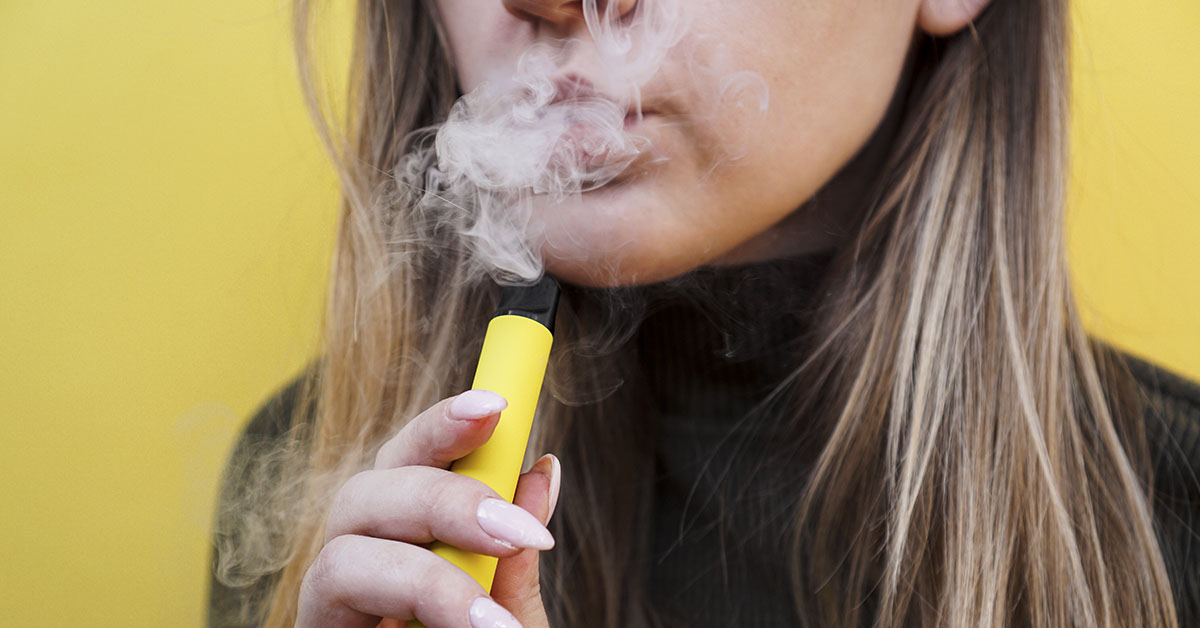Vaping has gained immense popularity in recent years as an alternative to smoking, with many people turning to e-cigarettes to quit their tobacco habit. While vaping may be perceived as a safer option, concerns have been raised about the rising number of children and young adults becoming addicted to nicotine through vaping. Doctors and Psychologists shed light on the scariest symptom of vape addiction: nicotine poisoning. These are the dangers of nicotine and vape addiction, its impact on children and young adults, and the alarming rise in cases of nicotine poisoning.
What Is Vaping and What Causes Vape Addiction?
Vaping is the act of inhaling and exhaling the vapor produced by an electronic cigarette or other similar device. The term “vape” comes from the word “vapor,” which refers to the gaseous state of a substance. E-cigarettes are battery-powered devices that heat up a liquid solution containing nicotine, flavorings and other chemicals to create an aerosol that users inhale. (1)
Vaping is a relatively new phenomenon, but it has already become popular among young people. The Centers for Disease Control and Prevention (CDC) reported that in 2023, 1 in 10 high school students reported using flavored e-cigarettes (vapes) in the last 30 days. Vape addiction occurs because the nicotine in e-cigarettes is highly addictive. Nicotine is a stimulant that affects the brain and central nervous system, causing feelings of pleasure and relaxation. It also increases heart rate and blood pressure, which can lead to heart disease and stroke. (2)
Read: Timeline of what happens to your body when you give up vaping
The Rising Concerns
According to reports from the hospitals, hospital admissions for children due to vaping quadrupled in a year in the United Kingdom. This has led to growing concerns about the addictive nature of vaping, especially among those who were never smokers. The UK government has expressed its worries and launched a consultation to address the issue. While vaping can be an effective cessation tool for adult smokers, it poses a significant risk when it comes to youth addiction to nicotine.
The news is not any better in the United States. The data shows across the board, young people are vaping at increasingly alarming rates. A big part of the problem is that nicotine is highly addictive, especially for teenagers. They don’t think that they will have a problem, but then they struggle to put the vape down voluntarily. According to Yale neuroscientist Marina Picciotto, PhD, the adolescent brain is more sensitive to rewards. The hit of nicotine that their brain receives when vaping is just that.
“Adolescents don’t think they will get addicted to nicotine, but when they do want to stop, they find it’s very difficult,” says Dr. Picciotto. (3)
Nicotine Addiction: The Telling Signs
Australian Psychologist Claire Wakefield highlights some worrisome signs indicating the development of nicotine addiction. One key red flag is when the thoughts of vaping become intrusive and overpowering. People may find themselves constantly thinking about where to get their next vape or experiencing anxiety when they are unable to access it. This uncontrollable fixation on vaping points towards a deeper dependency and a potential addiction.
“The clues for me that I reckon are worrying, is when you start thinking about it when you don’t want to think about it,” said Wakefield. “You wake up in the morning and the first thing you think is, ‘Where’s my vape?’ Or if you get, like, anxiety about wondering where I’m going to get my next one.” (4)
The Scary Symptom: Nicotine Poisoning
Wakefield further delves into the dangerous consequences of nicotine addiction—nicotine poisoning, also known as “nic sick.” Vapes and e-liquids contain higher levels of nicotine than traditional cigarettes. This increased nicotine content puts individuals at a greater risk of nicotine poisoning, characterized by an excessive intake of nicotine in a short period. The American Lung Association warns that nicotine poisoning can have severe implications, ranging from nausea, vomiting, and dizziness to headaches, confusion, diarrhea, shallow breathing, extreme fatigue, and in extreme cases, even fatality. (5)
Read: “Stop Vaping, We Beg Of You,” Doctors Warn As 17-Year-Old Who Vaped Receives Double Lung Transplant
Impact on Children and Young Adults
Children and young adults are particularly vulnerable to the risks of nicotine addiction through vaping. The addictive nature of nicotine can have long-term consequences on their developing brains and bodies. It is alarming to note that some youngsters have reported experiencing nicotine poisoning symptoms after excessive vaping.
Wakefield highlights a harrowing case of a young woman who began throwing up strawberry-flavored vomit, an indication of excessive vape usage. Such stories underscore the severity of nicotine poisoning and raise concerns about the physical and psychological effects it has on young individuals.
“She says she knew she had a problem when her vomit started tasting like vape,” said Wakefield. “Strawberry-flavored vomit, because she’d had so much vape. If you Google ‘Vape burns’, it’s not pretty.”
Vape Addiction: The Bottom Line
As the popularity of vaping continues to rise, so does the prevalence of nicotine addiction, especially among children and young adults. The scariest symptom of this addiction is undoubtedly nicotine poisoning, with its potentially grave consequences. It is crucial for parents, educators, healthcare professionals, and policymakers to address this issue urgently and take proactive steps to protect children and young people from the harmful effects of nicotine addiction through vaping.
While efforts are being made to regulate access to vaping products, education and awareness play a vital role in preventing the onset of nicotine addiction and the subsequent nicotine poisoning. By understanding the risks and alarming symptoms associated with vape addiction, we can work towards curbing this worrisome trend and safeguarding the wellbeing of our younger generation.

